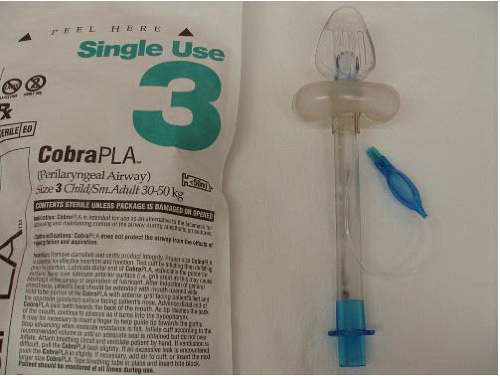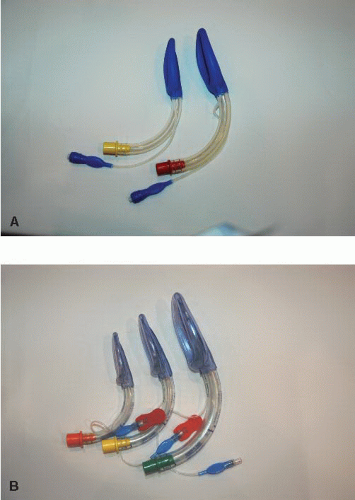Laryngeal Mask Airways
Michael F. Murphy
Jennifer L. Avegno
INTRODUCTION
The laryngeal mask airway (LMA) is an extraglottic device (EGD) (i.e., a device that provides ventilation without any part of it passing through the vocal cords) that was introduced in 1981 as an alternative to mask anesthesia. Some 30 years later, LMA-type devices enjoy widespread use in a variety of patient and clinical settings and have become accepted adjuncts in emergency management of both routine and difficult airways.
TERMINOLOGY
The terminology of the EGDs is not standardized and has been confusing. Some authors refer to a device either as a supraglottic device (SGD) or as a retroglottic device (RGD), the latter also sometimes referred to as an infraglottic device (IGD). The term RGD or IGD has been used to refer to those devices that pass behind and beyond the larynx to enter the upper esophagus (e.g., Combitube, King LT airway, and EasyTube). Only certain designs are truly supraglottic, such as the various LMAs and the CobraPLA (PeriLaryngeal Airway).
We refer to any member of this entire family of devices as an EGD, and consider two subclasses: the SGDs, which sit above and surround the glottis (almost all of which are some type of LMA) and RGDs (or, less precisely, IGDs), which enter the upper esophagus (e.g., Combitube). Most EGDs are single-use, but some are available in reusable variants.
EGDs differ from face mask gas delivery apparatus in that they are inserted through the mouth to a position where they provide a direct conduit for air to flow through the glottis and into the lungs. They vary in size and shape, and most have balloons or cuffs that when inflated provide a reasonably tight seal in the upper airway to permit positive-pressure ventilation with variable limits of peak airway pressure.
Although bag-mask ventilation (BMV) is relatively simple in concept, it is difficult or impossible to perform in selected patients (see Chapter 9), even in the hands of experts. Use of an EGD is a more easily acquired skill than BMV for the nonexpert airway practitioner. Similarly, tracheal intubation is the “gold standard” for effective ventilation and airway protection from aspiration, but the skill is not easily mastered or maintained. EGDs are a viable alternative to tracheal intubation in many emergency settings, particularly in prehospital care.
Finally, airway management difficulty and failure are associated with significant morbidity and mortality. Certain EGDs have a potential role in both the difficult (LMA) and failed (most EGDs) airway (see Chapters 2 and 3).
Thus, the indications for these devices have expanded over the past three decades and include potential for use as
An airway rescue device when BMV is difficult and intubation has failed.
A “single attempt” rescue device performed simultaneously with preparation for cricothyrotomy in the “can’t intubate, can’t oxygenate” (CICO) failed airway (see Chapter 3).
An easier and more effective alternative to BMV in the hands of basic life support providers or nonmedical rescue personnel.
An alternative to endotracheal intubation by advanced life support providers.
An alternative to endotracheal intubation for elective airway management in the operating room (OR) for appropriately selected patients.
A conduit to facilitate endotracheal intubation (various types of intubating LMAs [ILMAs]).
SUPRAGLOTTIC DEVICES
The Laryngeal Mask Company developed the original SGD, the LMA Classic (Fig. 10-1), which serves as the prototype for much of the supraglottic class, although other designs exist. The
company also makes several other versions of the LMA, including both reusable and nonreusable (disposable) devices:
company also makes several other versions of the LMA, including both reusable and nonreusable (disposable) devices:
 Figure 10-1 • LMA Classic. Note the aperture bars at the end of the plastic tube intended to limit the ability of the epiglottis to herniate into this opening. |
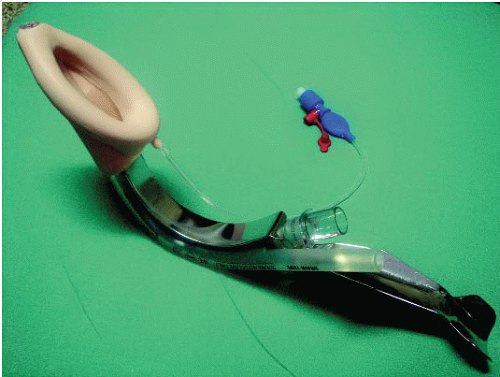 Figure 10-2 • LMA ProSeal. Note the drain tube and distal orifice to permit gastric tube passage and drainage. |
LMA Unique (disposable variant of the LMA Classic)
LMA Flexible (reinforced tube variant of the LMA Classic)
LMA ProSeal (reusable) (Fig. 10-2)
LMA Supreme (disposable) (Fig. 10-3)
Fastrach or ILMA (reusable and disposable) (Fig. 10-4)
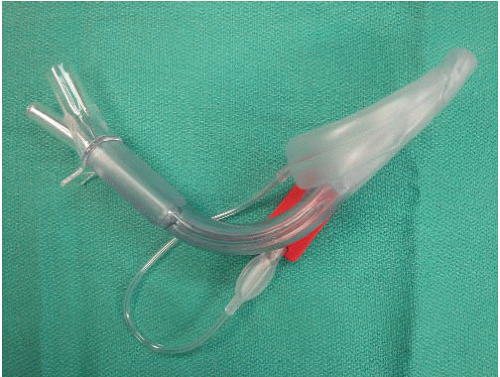 Figure 10-3 • LMA Supreme. The rigid construction of the tube and the curvature of the device enhance insertion characteristics and the immediacy of the seal obtained once inflated. |
Other companies also make SGDs, both LMA type and non-LMA type, including
A variety of disposable LMA Classic type designs (e.g., Portex and Solus)
Ambu LMA (ALMA) family of devices (AuraOnce, Aura Straight, Aura-i; disposable and reusable) (Fig. 10-5)
CobraPLA (disposable) (Fig. 10-6)
Cookgas ILA (reusable) and Air Q (disposable) (Fig. 10-7A and B)
I-Gel (Fig. 10-8)
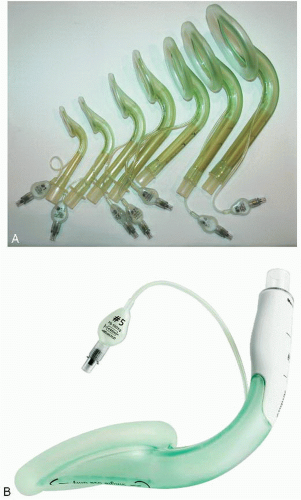 Figure 10-5 • A: Range of sizes of the Ambu AuraOnce LMA. B: Ambu Aura-i LMA, specifically designed to be used with the Ambu A Scope for endoscopic intubation. |
The LMA-type SGDs are easy to use, generally well tolerated, produce little in the way of adverse hemodynamic responses on insertion, and play a significant role in both routine and rescue emergency airway management. Ventilation success rates near 100% have been reported in OR series, although patients with difficult airways were excluded. It is likely that emergency airway ventilation success rates are somewhat lower. Intubation success rates through the ILMA are consistently in the 95% range, comparable to success rates with flexible endoscopic intubation and significantly better than through the standard LMA (about 80%). However, an LMA does not constitute definitive airway management, defined as a protected airway (i.e., a cuffed endotracheal tube [ETT] in the trachea). Although they do not reliably prevent the gastric insufflation or the regurgitation and aspiration of gastric contents, LMAs confer some protection of the airway from aspiration of blood and saliva from the mouth and pharynx.
Maximal success is only achievable when the patient has effective topical airway anesthesia (see Chapter 23) or is significantly obtunded (e.g., by rapid sequence intubation medications) to tolerate insertion of these devices.
LARYNGEAL MASK COMPANY DEVICES
Standard, Non-ILMAs
The original LMA, now called the LMA Classic, was introduced into clinical practice in 1981 and looks like an ETT equipped with an inflatable, elliptical, silicone rubber collar (laryngeal mask) at the distal end (Fig. 10-1). The laryngeal mask component is designed to surround and cover the supraglottic area, providing upper airway continuity. Two rubber bars cross the tube opening at the mask end to prevent herniation of the epiglottis into the tube portion of the LMA.
The LMA Classic is a multiuse (reusable) device. The disposable and much less costly variety of this device is called the LMA Unique. A similar product, the LMA Flexible, incorporates wire reinforcement in the tube portion of the device to prevent kinking as the tube warms. We do not recommend the LMA Flexible for management of the emergency airway.
The reusable LMA ProSeal incorporates an additional lumen through which one can pass a suction catheter into the esophagus or stomach. In addition to the standard perilaryngeal cuff, it also has a “directional sealing cuff” dorsally. This design modification results in higher sealing
pressure capacity than the LMA Classic (28 vs. 24 cm H2O), theoretically conferring an advantage for ventilating patients requiring higher airway pressures, although the difference may not be clinically significant. Because of its expense, relatively difficulty with insertion characteristics, and marginal benefit in the emergency situation, the LMA ProSeal does not currently have a place in emergency airway management.
pressure capacity than the LMA Classic (28 vs. 24 cm H2O), theoretically conferring an advantage for ventilating patients requiring higher airway pressures, although the difference may not be clinically significant. Because of its expense, relatively difficulty with insertion characteristics, and marginal benefit in the emergency situation, the LMA ProSeal does not currently have a place in emergency airway management.
A disposable device similar to the LMA Classic called the LMA Supreme has compelling design characteristics that may make it suitable for emergency airway management. It is easy to insert, seals readily, has a built-in bite block, and has a channel through which a gastric tube can be passed. This device can be considered as a replacement for BMV and endotracheal intubation in the hands of nonexpert airway managers and is the preferred device for emergency airway management if a nonintubating style of LMA is desired.
Intubating LMAs
The LMA Fastrach, also called the ILMA, is the most important version of the LMA for emergency airway management because it combines the high insertion and ventilation success rate of the other LMAs with specially designed features to facilitate blind intubation. It has an epiglottic elevating bar and a rigid guide channel that directs an ETT in a superior direction into the larynx, enhancing the success rate when passed blindly. The LMA Fastrach device is a substantial advance in airway management, particularly as a rapidly attempted rescue device in the CICO situation while preparations for cricothyrotomy are underway. It is supplied in both reusable and disposable forms.
Indications and Contraindications
The standard LMA is now widely used in anesthetic practice instead of mask anesthesia, and the LMA Fastrach is an accepted device in emergency and failed airway management.
The LMA and LMA Fastrach have two principal roles in rescue emergency airway management: (1) as a rescue device in a “can’t intubate, can oxygenate” situation, and (2) as a single attempt to effect gas exchange in the CICO failed airway as one concurrently prepares to perform a cricothyrotomy (see Chapter 3). The success rate of LMA-facilitated ventilation in the difficult airway may be eroded if multiple preceding intubation attempts have traumatized the upper airway.
The handle of the LMA Fastrach enhances its insertion characteristics and allows for manipulation to achieve optimum seal once the cuff is inflated. The LMA Fastrach can be used as a rescue device for a CICO airway when upper airway anatomy is believed to be normal, thus allowing for a proper “seat.” These devices have been used successfully in pediatrics, by novice intubators, during CPR, and in emergency medical services (EMS).
Technique: LMA Classic, LMA Unique, and LMA Supreme
The LMA Classic, Unique, and Supreme can all be rapidly inserted as primary airway management devices, or to rescue a failed airway. First, the appropriate size of LMA should be selected based on patient characteristics. The LMA Classic and Unique come in sizes 1 to 6 (ranging from neonates <5 kg to adults >100 kg); the Supreme sizes range from 1 to 5. For adults, the simplest sizing formula is weight-based, regardless of patient size: size 3, 30 to 50 kg; size 4, 50 to 70 kg; and size 5, >70 kg. For patients on the borderline between one mask size and another, it is generally advisable to select the larger mask because it provides a better seal.


